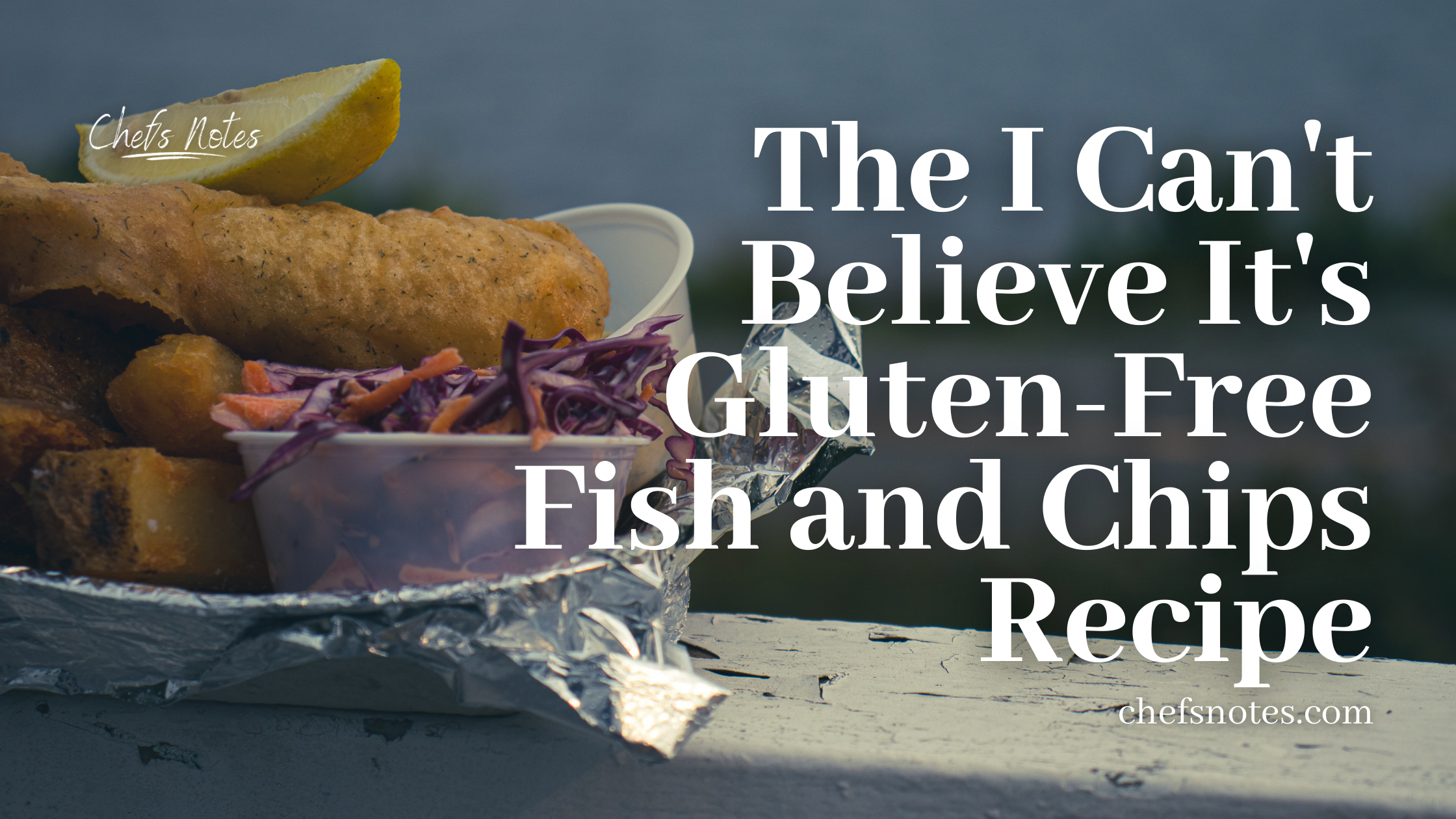Eating gluten-free can be very frustrating. I crave lots of foods but rarely do the gluten-free versions live up to their gluten-containing cousins. I find this to be especially true in restaurants. All too often, restaurants treat gluten-free food like health food. There is a place for that, no doubt. But, just because I have to eat gluten-free doesn’t mean I don’t also want junk food. Luckily, I’m a chef, and I can make whatever I want. What’s more, is that I can then share that with you. And boy, am I excited to share this gluten-free fish and chips recipe with you!
What’s great about this gluten-free fish and chips recipe is that whether you eat gluten or not, I am willing to bet that this will be one of the best fish and chips you’ve ever had. I know. That’s a bold statement. But I stand behind it. If you do eat gluten, substitute the gluten-free flour for regular all-purpose flour. Are you ready for this? I know I am. Let’s get to it!
You can always find the recipes directly below but keep reading for more information and a more detailed walkthrough.

Gluten-Free Fish and Chips Recipe
Ingredients
Fish
- 2 large cod fillets cut into two to three pieces each
- 1 1/2 cups gluten-free all-purpose baking flour, separated I used Bob's Redmill
- 1 tsp baking powder
- 1/2 tsp dried dill
- zest of 1 lemon
- 1/2 tsp kosher salt
- 1/4 tsp black pepper
- 1 egg
- 1 cup soda water
- oil for frying
Fries (chips)
- 2 large russet potatoes
- oil for frying
- salt
Instructions
Fish
- In a large mixing bowl, combine 1 cup of flour, the baking powder, dill, salt, pepper and lemon zest. Mix well.
- Add the egg and soda water. Mix until fully incorporated.
- Put the batter in the fridge for 20 minutes before using it.
- Dredge the cut fish in the remaining flour, shake off any excess.
- Dip the fish in the batter, and fry two to three pieces at a time in a deep fryer or high-sided pot at 365°f. Fry for about 7 minutes, flipping halfway through.
- Serve right away.
Fries (chips)
- Wash the potatoes with a brush under cold running water.
- Cut the potatoes into rectangles about 2 cm (3/4 of an inch) wide and the length of the potato.
- Put the cut potatoes in a pot, and rinse with cold water until the water runs clear. Fill the pot with water, add a big pinch of salt, and bring to a boil on high heat.
- Cook the potatoes until they just start to break when poked with a fork.
- Drain the potatoes and spread them out onto a cooling rack. Let the potatoes sit for about 10 minutes.
- Fry the potatoes in batches on 325°f until they just start to turn golden brown. This will take between 5 to 7 minutes. Shake the excess oil off the fries and return them to the cooling rack. Allow the potatoes to cool to room temperature before frying again.
- Turn the heat up on the oil until it reaches 165°f.
- Fry the fries again for about 5 minutes or until a deep golden brown. Drain, and toss in a medium mixing bowl with a big pinch of kosher salt. Serve immediately.

How To Make Gluten-Free Fish and Chips
What makes good fish and chips?
So, what makes good fish and chips? Well, let’s start with the fish. The fish should be tender and flaky and not overcooked. The batter should be cooked all the way through, crisp, golden brown, and flavourful. It shouldn’t be greasy or soggy at all. The fries should crunch when you bite into them, but the inside should be soft and fluffy. Sound good? Well, that’s exactly what we are going to make.

The Fries (Chips)
Let’s start with the fries. Now, these are no ordinary fries. These are thick hand-cut fries that are the crispiest on the outside, fluffiest on the inside fries you will probably ever have. There is a secret technique that I first learned from Heston Blumenthal that we would look at. Let’s take a look.
Hand Cutting Fries
Often when you see “Hand-cut fries” on a menu, they mean that the fries are cut in-house using a fry cutter. Here, when I say “hand-cut,” I mean hand-cut. I really wanted to make these fries extra crispy and do that properly the fries need some body. That’s why I went with thick-cut fries. The fact that they are much easier to cut never even crossed my mind.
First, wash the potatoes with a brush or cloth under cold running water. Pat them dry and cut the potato, lengthwise, into thumb-width sticks. Put the fries in a pot and rinse them with few changes of cold water. Do this until the water runs clear.






Boiling The Fries
Put the fries on the stove on high heat and bring them to a boil. Cook the potatoes until they are soft enough to break when poked with a fork, but not so much they are complete mush. This should take about 10 minutes of boiling, maybe a little longer. Once the potatoes are cooked, drain off the water and put the fries on a cooling rack. As the potatoes sit on the rack, all the excess moisture in the potato will evaporate, and the potatoes will dry. They will also change from a yellow-ish colour to white. Let the potatoes sit for at least 20 minutes.
Why boil the potatoes?
Boiling the potatoes obviously softens them, but it also adds texture to the potato’s surface. This texture is vital to getting that really crispy outer shell on the finished fries.




Blanching The Fries
The next step to making these ridiculously crispy fries is to blanch them in oil. If you’ve ever made fries before you are probably familiar with this step. Usually, this first cook in oil is done at a lower temperature than the final fry. The purpose is to cook the potato all the way through. But, our potatoes are already cooked, so why bother to do this? That’s a good question. This first fry is going to do two things. First of all, it is going to help remove any residual moisture hiding out within the fries. Secondly, it is going to start building up that crispy outer layer. Generally, this first fry would be done at 300°f. But, for our purposes, we will fry the potatoes at 345°f for about 5 to 7 minutes or until the potatoes start to turn golden brown.



Cooling the fries
Once the fries have been blanched in the oil, they will need to cool to room temperature before being fried again. It’s actually best if you cool them in the fridge, but it isn’t strictly necessary. Cooling the potatoes will help them get really crispy. Cool the fries on a cooling rack rather than on a flat surface. This will help prevent the fries from becoming greasy. Also, keep in mind not to overload your fryer. Fry the potatoes in two to three batches, giving the fryer time to come back to temperature after each fry.
Frying The Fries
Okay, you’ve washed, hand-cut, boiled, dried, fried, and cooled your potatoes. All that’s left is to fry them once more, add a pinch of salt and enjoy. For this final fry, turn your fryer up to 365°f. Put the fries in. You can do more per batch than when blanching. Fry for 5 to 7 minutes or until the fries are deep golden brown and very crisp. Take the fries out of the oil, drain, and then toss in a mixing bowl with a large pinch of kosher salt. Serve immediately.


Do you need a deep-fryer to make this?
You don’t absolutely need a deep-fryer to make this, but it is the safest option. Your other choice is to fry the fish and potatoes in a pot or wok full of oil. If you go this route, make sure to leave at least 2 to 3 inches of headroom in the pot, so the oil doesn’t overflow. Also, put the pot or wok on the back burner, so it is less likely to be bumped or knocked. If using a pot or wok, you will also need a candy or a deep-frying thermometer to know the temperature of the oil. If you do this, please be careful. Hot oil is hazardous, and you do not want to spill it on yourself or someone else. Also, if the oil overheats, it can catch on fire. If that happens, cover the pot with a lid and call 911. DO NOT PUT WATER ON A GREASE FIRE!!
What type of oil should you use?
Typically, canola oil is used for frying. It is fairly cheap and has a high smoke point. However, for a cleaner flavour and to possibly be a little healthier, use peanut oil. It is more expensive, but I prefer it for frying. And, you can strain it, put it in a sealed jar and keep it in the fridge for months. Just pull it out anytime you want to fry something.
Gluten-Free Battered Fish
How-To Make Gluten-Free Fish Batter
Okay, we’ve made the fries now. Let’s move on to the fish. The fish batter is actually the same as the gluten-free sweet and sour chicken ball recipe I made a while back. The only difference is that I add dill, lemon zest, and black pepper for the fish batter. This battered is made gluten-free not by adding a bunch of crazy ingredients but rather by using gluten-free all-purpose or baking flour. To make it not gluten-free, use normal all-purpose flour. The other ingredients in the batter are baking powder, salt, an egg, soda water, and, as I said, dill, lemon zest, and black pepper. Mix the batter and put it in the fridge for 20 minutes to chill. The colder the batter, the crisper it will be.










Prepping The Fish
You can use any flakey white fish for this recipe. Haddock and catfish are good options, but I was lucky enough to get some cod, so that’s what I went with. I had two huge cod fillets so I cut each into three pieces. Pat, the fish, dry, then toss it in half a cup of gluten-free flour (or regular all-purpose).


Batter and Fry The Fish
Shake the excess flour off the fish and dip it in the batter. Lift the fish out of the batter, letting any excess drip off and place it in the fryer. When you do this, have the fryer basket down. If you put the fish on the basket then put it in the oil, the fish will cook onto the basket. Use a fork and make sure the piece of fish the fork is through isn’t going to break off. Dip the fish in the hot oil about halfway, then gently swirl it around for a few seconds before letting it gently slip off the fork and into the oil. This will help start the crust formation, which will help prevent the fish from sticking—Fry the fish at 365°f for about 6 to 7 minutes. If you want to serve it right away, fry it for 10 to 12 minutes. Either way, flip it halfway through.







Double Fry The Fish
You can single fry this fish, and it will be great. But, I find a double fry is a better option. Double frying allows you to have all the fish cooked and ready to go, then you can finish it in the fryer right before serving to get it really crispy. This is best if you are cooking for a group of people because you can fry more fish at a time on the second fry. You can also batter the fish and do the first fry a day ahead, store it in the fridge on a cooling rack uncovered, then fry it when you want. The second fry should be done at 365°f and will take about 5 minutes.
I can’t believe it’s gluten-free fish and chips
That little bit of lemon and dill really comes through and compliments the flavour of the fish perfectly. Serve the gluten-free fish and chips with tartar sauce and coleslaw. If you have the option, eat the fish and chips by the water to really make the whole experience special.




The Wrap-Up
I am so excited for you to try this recipe. I cannot express enough how delicious it is. I’d been craving fish and chips for a while, and this really hit the spot for me. Yes, I know it takes a while to make, but make a Sunday of it. Invite some friends over, have a few drinks (not too many around the hot oil) and enjoy yourself. That’s what food like this is for. Happy cooking and even happier eating, everyone!
Thanks for reading, and remember to check out my brand new cookbook, “The How-To Cookbook For Men” It comes out on August 10th and is available for preorder here.
Never miss a post again. Put your email address in the box below and receive chef’s notes in your inbox.



I think 99% of gluten free cooking revolves around making a decent flour/wheat substitute. So was a bit disappointed to see I needed to go buy a packet of somebody else’s flour. Was hoping for a recipe to make good batter from scratch.
Hi Rich, that’s a completely fair criticism. The goal of this blog is to make cooking as simple as possible for as many people as possible and the reality is, most people don’t want to buy five or six ingredients to create their own gluten-free flour mix. Especially now that there are so many high quality ones out there.